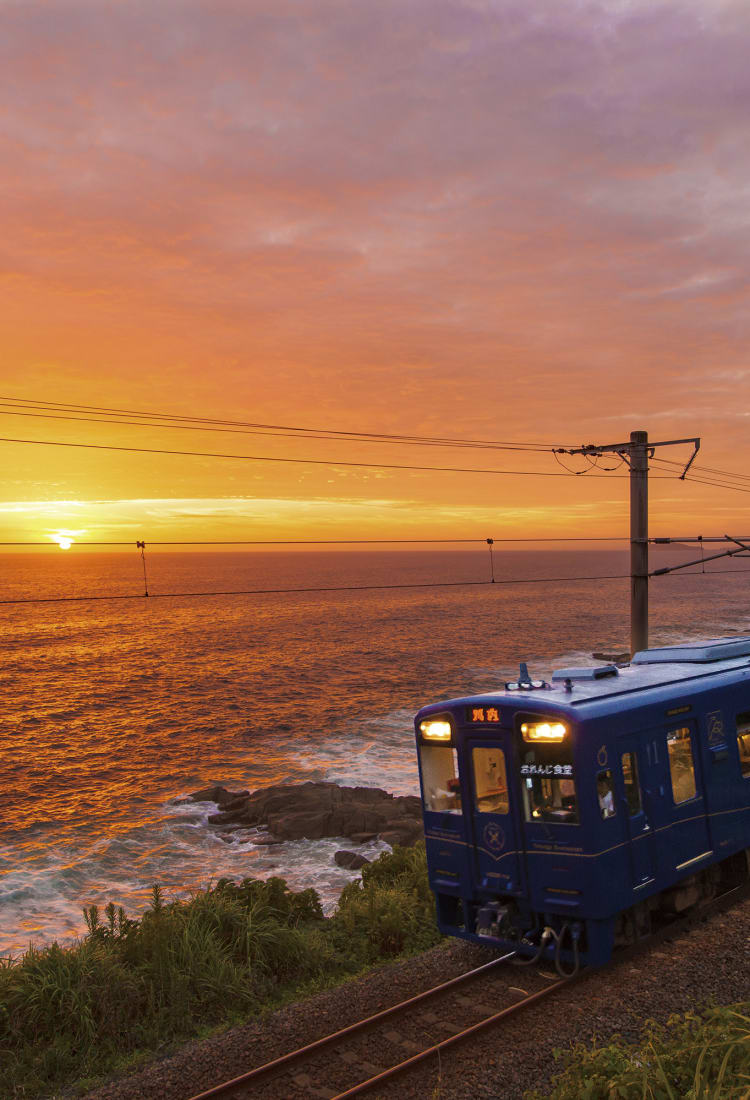
2021.01 Discover the Sights and Tastes of Kyushu Through Unforgettable Rail Journeys
Choose from a range of trips, including a short ride from the Ibusuki hot spring resort to Kagoshima City at the island’s southern tip or a more extended trip that threads through Kumamoto in central Kyushu. JAPAN RAIL PASS holders can use their pass on some sightseeing trains. Enjoy a different Japan travel experience by exploring the island of Kyushu by train.
Ride the Ibusuki no Tamatebako and experience an awe-inspiring live volcano
Ibusuki is the starting point for the Ibusuki no Tamatebako sightseeing train. The hot spring resort has more than 1,000 hot springs, but Ibusuki’s most famous baths are arguably the ones with no water at all—the natural hot sand baths (sunamushi.) At these baths along the coast, bathers are covered in sand and warmed by volcanic steam that reaches temperatures of 50–55 degrees Celsius (122–131 degrees Fahrenheit). These rare natural hot sand baths are a popular draw with domestic and international visitors alike.
Ibusuki is around three and a half hours from Tokyo by airplane and bus. Visitors arriving in Fukuoka can reach Ibusuki in around three hours from Hakata Station with a combination of shinkansen and local trains.

Ibusuki Station. (left) Hot sand baths have a 300-year history. Guests wear yukata and are covered in warm sand. (right)
The Ibusuki no Tamatebako sightseeing train runs between Ibusuki and Kagoshima Chuo stations. The train is operated by JR Kyushu and is covered by the JAPAN RAIL PASS. Industrial designer Eiji Mitooka designed the train, opting to paint the carriages a distinctive black-and-white. Mitooka has been awarded the Brunel Award (an international railway design competition) multiple times and worked on the designs of over 15 JR Kyushu sightseeing trains, including the luxury train Seven Stars in Kyushu.
The Ibusuki no Tamatebako runs along scenic Kinko Bay for around 50 kilometers (31 miles). The bay was formed after Sakurajima—one of the world’s most active volcanoes and a dominant feature of the Kagoshima landscape—violently erupted.
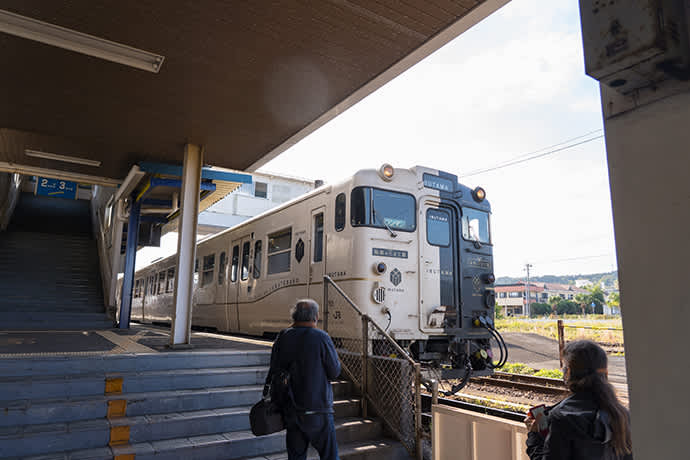
The Ibusuki no Tamatebako has a distinctive two-tone design; the white side faces the ocean, and the black side faces the mountains.
As the train pulls into Ibusuki Station and the doors open, an atmospheric cloud of vapor is emitted, adding to the fantastical atmosphere of the train.
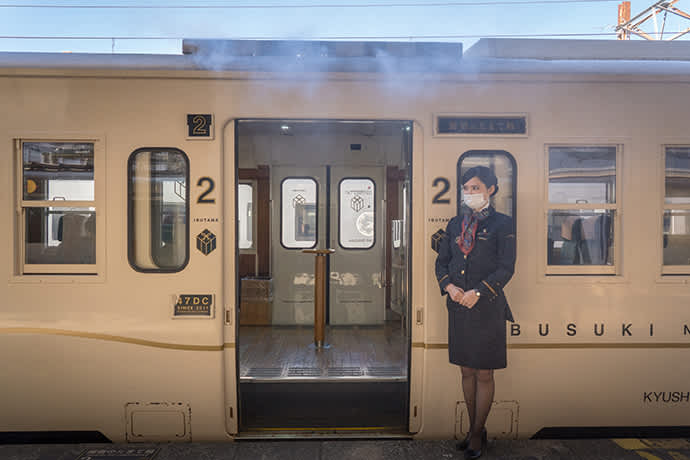
A cloud of vapor billows out from above the train doors.
The train is comprised of two cars. The first car has a classic design using luxurious teak, similar to that used in yachts and grand passenger ships.
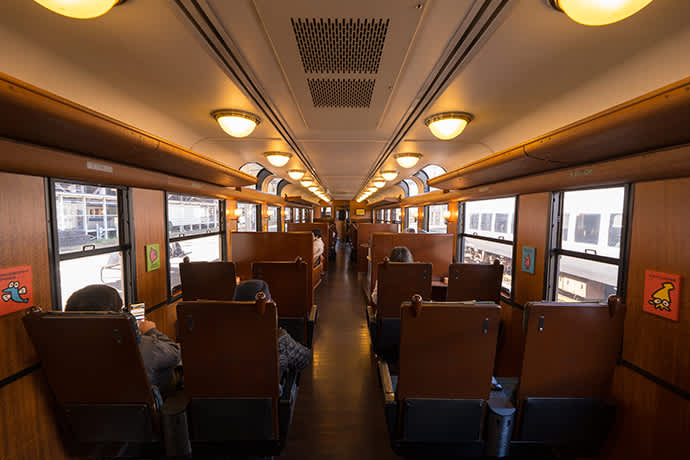
The first car has a quiet, sophisticated atmosphere.
In contrast, a light cedar wood from southern Kyushu was used for the interior in the second car, brightening the ambience. There are various seat types in both cars. The ocean-facing swivel chairs are particularly popular and tend to book out quickly.
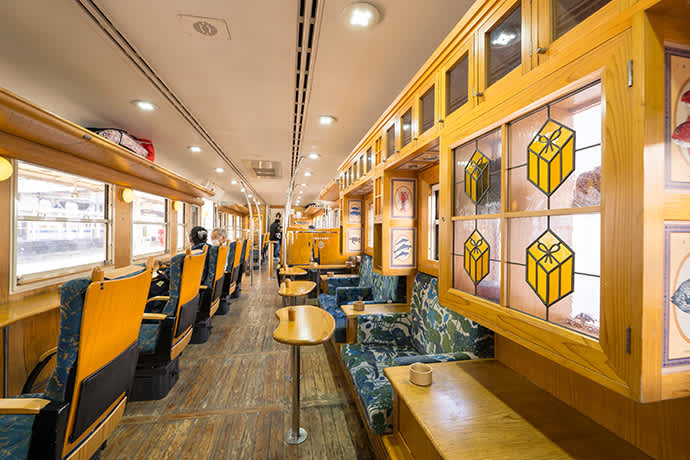
The seat fabric in the second car has undersea patterns and motifs.

Both cars have sofas in an open area that faces the sea. The second car has kids’ chairs and a playpen.
Passenger safety is a priority on all trains in Kyushu and measures to prevent the spread of COVID-19 are thoroughly implemented. All train staff wear masks, and the carriages are regularly disinfected. Passengers are asked to wear a mask while on board. All cars on the JR Kyushu shinkansen and express trains are well ventilated, utilizing an efficient air-conditioning system.
Once the train pulls out from Ibusuki Station, the urban landscape shortly gives way to expansive views of Kinko Bay and the uninhabited island of Chiringashima. The island is connected to the mainland by a sandbar that only appears at low tide between March and October. Mt. Uomi connects to the island and is a well-known scenic vista called the “Hawaii of the East”.

A view of Chiringashima from the train. The island is connected to the shore by a sandbar, between March and October.
While on board, passengers can purchase limited-edition snacks and drinks. These include Ibusuki Onsen Cider—a soft drink made from water that flows in the Ibusuki Valley—and an Ibutama sweet set that features cookies made from locally grown broad beans and shortbread flavored with Chirancha tea, a local brand from Minamikyushu City.

Popular items to buy on the train include a towel with an original design and Ibu-Tama pudding that mimics the same two colors as the train.
Kyushu’s sightseeing trains offer more than a simple scenic trip down the tracks. The name of the train, Ibusuki no Tamatebako, means “Ibusuki’s Treasure Box” in Japanese, and there is a “treasure box” on the train. Passengers can leave a message in this special wooden box that sits on the counter in the first car, and train crew will read the message aloud during the trip. Train staff are also on hand to take snaps of passengers holding a commemorative sign.

Passengers will find a commemorative train stamp next to the treasure box, which they can use to stamp a notebook or a piece of paper as a memento of their trip. These special stamps are common at many train stations and tourist sites across Japan.
Shortly after the train pulls out of Kiire Station, passengers will spot the volcanic island Sakurajima across Kinko Bay. Plumes of volcanic steam regularly spout from the crater of the active volcano and catching sight of Sakurajima is the highlight of any trip to Kagoshima. As the train skirts the bay, passengers are afforded plenty of opportunity to gaze at this 26,000-year-old “symbol of Kagoshima.”
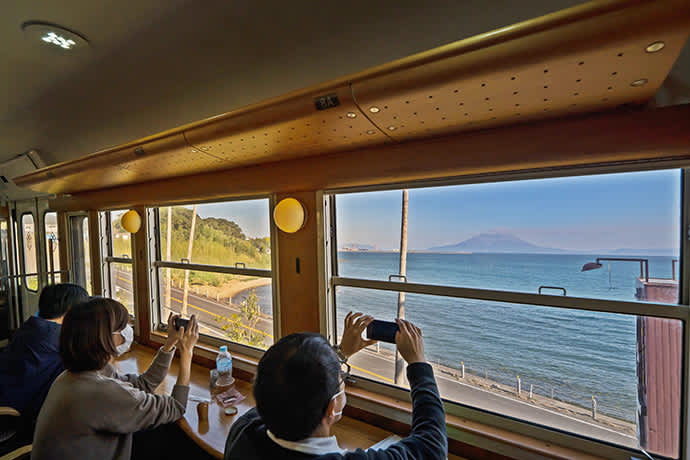
The island of Sakurajima with its impressive volcano, is clearly visible from the train. The volcanic island is 15 minutes by ferry from Kagoshima’s port area.
Sakurajima is clearly visible as the train approaches Kagoshima Chuo Station, the final destination. The imposing volcano is a stark reminder of the power of the earth.

Plumes of smoke rise from Sakurajima.
The trip is over as the train pulls slowly into Kagoshima Chuo Station, just under an hour after leaving Ibusuki Station. The Ibusuki no Tamatebako runs up and down the line three times a day; in the morning, middle of the day and afternoon.

The Ibusuki no Tamatebako hugs the coastline as it travels between Ibusuki and Kagoshima Chuo stations. Photo credit: Hirokazu Fukushima
Experience traditional cuisine and stroll one of Japan’s most remarkable gardens
After alighting at Kagoshima Chuo Station, visitors can explore the rich historical area. Sengan-en is a historic private villa surrounded by extensive gardens, about 15 minutes by bus from Kagoshima Chuo Station. The villa complex was built in 1658 by the Shimazu family who governed Kagoshima at the time. Altogether, the home and gardens span around 5 hectares (approx. 12 acres). The renowned scenic spot is one of the largest gardens in Japan, using “borrowed scenery”, including Sakurajima and Kinko Bay.
The villa is part of the World Cultural Heritage site collectively called “Sites of Japan’s Meiji Industrial Revolution.” In the late nineteenth century, Shimazu Nariakira built a factory and furnace next to Sengan-en, which combined traditional Japanese craftsmanship and western technology, contributing to the modernization of Kagoshima.

Guided garden tours are available in English and Chinese (*currently, suspended due to COVID-19). Photo credit: Shimadzu Limited
Visitors to Sengan-en might consider dining at Ohkatei, a restaurant in the grounds. Diners can try local dishes such as a shabushabu, a hot pot featuring the Kagoshima specialty, kurobuta pork, and dumplings made of deep-fried fish paste, called satsumaage. The restaurant has prime views of Sakurajima on the opposite shore about 4 kilometers (2.5 miles) away.

Savor delicious local food and enjoy the spectacular view. Photo credit: Shimadzu Limited
Strolling around Sengan-en is an opportunity for visitors to engage in local history and appreciate the beauty of Japanese gardens. After wandering around the elegant house that once hosted important figures from Japan and abroad, guests can explore the tasteful garden that blends traditional Japanese style with Chinese and Ryukyu culture.

The house’s reception room, Ekken no ma, is an authentic historical recreation. Photo credit: Shimadzu Limited

Visitors can have a photo taken in authentic samurai armor. (left) The workshop in the grounds sells Satsuma Kiriko, a traditional style of glassware from Kagoshima. (right) Photo credit: Shimadzu Limited
Dramatic sunsets and local foods on the Orange Restaurant sightseeing train
The Orange Restaurant (Orange Shokudo) is a privately-run sightseeing train with an emphasis on local food. The train runs three times a day, for breakfast, lunch and dinner. On each trip, passengers can savor seasonal dishes prepared with carefully selected local ingredients. The dinner train departs before sunset, offering beautiful views as the sun goes down (weather permitting) as the train travels along the west coast.
Journeys start at Sendai Station, about 15 minutes by shinkansen from Kagoshima Chuo Station, before running one of several routes along the coast from Kagoshima to Kumamoto. The trip to Izumi in Kagoshima covers approximately 117 kilometers (73 miles) in just under two hours.

Eiji Mitooka designed the retro-looking train.
The train has two cars; a classic dining car and a lounge car with a spacious seating area. The lounge car has tables for two next to the windows and sofas positioned to maximize ocean views (Tables where passengers sit across from one another currently cannot be reserved due to measures to prevent the spread of COVID-19).

The dining car. (left) The lounge car. (right)
A loud bell ring marks the start of the journey to Izumi. After rumbling through the city, the train reaches the coast, at which point the appetizers are brought out and dinner begins. The dinner menu was developed at Le Plaisir, a patisserie in the city of Sendai.

An example of an appetizer served on Orange Restaurant, a fillet of tuna caught in Sendai Port, served with pistachio-flavored mashed potatoes.
The train reaches the first stop, Satsuma Taki Station, after around 12 minutes. Here, passengers can disembark and walk to the beach. The staff of Orange Restaurant spent several years clearing a walking path through the brush and trees to allow easy access to the beach. The departure time of the dinner train is adjusted to coincide with the sunset, therefore, weather permitting, visitors may see the sun setting over the East China Sea.

The train stops for about 15 minutes to allow passengers to walk to the beach.
After enjoying the beautiful sunset, guests return to the train where crew members will explain the locally produced shochu available to diners. The Kyushu region is known for shochu, a Japanese distilled liquor primarily made from ingredients such as barley, sweet potato, and rice. Kagoshima is noted for shochu made from sweet potato.

Train crew can speak conversational English and also carry a translation device. (left) Passengers can choose from a menu of around 15 types of shochu from Kagoshima and Kumamoto. (right)
Shortly after the journey recommences, passengers can glimpse an unusual rock formation on the coast, known as the Doll Rock (Ningyo-Iwa). The rock looks like a mother holding her child and is an especially beautiful sight at dusk.

Passengers catch a brief glimpse of Doll Rock, as the train passes between tunnels. (left) Passengers can enjoy spectacular views from the train as it hugs the coastline between Satsuma-Taki Station and Nishikata Station. (right)
The soup course is made from local ingredients such as a corn potage produced from locally grown pilled millet and sweet corn. Dishes vary depending on what ingredients are in season.

Soup served with a crunchy cheese stick (left), a delicately flavored dish of pan-fried flounder (right).
The main dish features locally sourced meats or fish, such as a layered kurobuta pork cutlet or pan-fried flounder caught off the coast of Akune, Kagoshima. The kurobuta pork, a specialty of Kagoshima, is very tender.
The train stops at Akune Station after sunset. The station was renovated in 2014, to resemble a stately guest house. The design, by industrial designer Eiji Mitooka
uses local wood. The waiting room resembles a concert hall, and live performances are sometimes held there. The station also has a café and souvenir shop.

Live performances are sometimes held in the waiting room. (left) There is a small library next to the waiting room. (right)
After a 10-minute stop at Akune Station, the train continues its journey, and dessert is served. The sweets make the most of local produce, such as a rich two-layer cheesecake with a tangy layer of bontan, a citrus fruit from Akune.

The evening’s dessert is arranged to resemble a sunset.
As the train travels towards Izumi, the final stop, visitors can browse displays of crafts from Kumamoto and Kagoshima in the second train car. The trip and the dinner are a relaxing, approximately two-hour journey that immerses visitors in the scenery, food, and culture of the area.
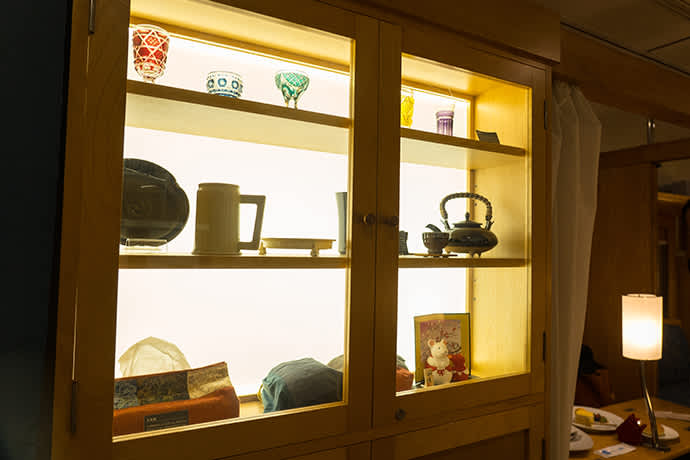
Passengers can see examples of local crafts in the second car.
Yatsushiro Station to Sendai Station serves a full course lunch, featuring ingredients from the sea, mountain, and fields along the line.

Breakfast, featuring artisanal breads. (left) A full course lunch. These photos are examples of the meals served until March 2021. Dishes are subject to change, depending on the available ingredients. (right) Photo credit: Hisatsu Orange Railway inc.
Themed trains in Kyushu
JR Kyushu operates several trains featuring distinctive designs and themes, across the region.
36 + 3
The newest sightseeing train started operating in 2020. The sleek black 36+3, themed on Kyushu, features a blend of Japanese and Western design elements and runs on five routes through all seven prefectures in Kyushu. Visitors can use the JAPAN RAIL PASS for the train ticket, but may need to pay an extra fee for some sections of the journey.

The train travels a total of 1198 kilometers (744 miles). The private compartments feature luxurious interiors. Photo credit: JR Kyushu
Aru Ressha
Aru Ressha, known as the “Sweet Train”, links Hakata and Nagasaki. The train’s design revives the image of luxury trains of 115 years ago. A world-class chef produces the seasonal dessert course served on the train. The Aru Ressha covers three routes, Hakata to Nagasaki Huis Ten Bosch, Saga to Sasebo via Nagasaki and Oita to Hita (Note that the route changes depending on the time of year).

The train livery in black and gold with an arabesque design, is distinctive. Dishes feature high-quality ingredients from Kyushu. Photo credit: JR Kyushu
Yufuin no Mori
The design of this resort train is imbued with the charms of Yufuin in Oita, one of the leading hot spring areas in Kyushu. The train is covered by the JAPAN RAIL PASS and takes passengers between Hakata in Fukuoka and Yufuin in Oita.
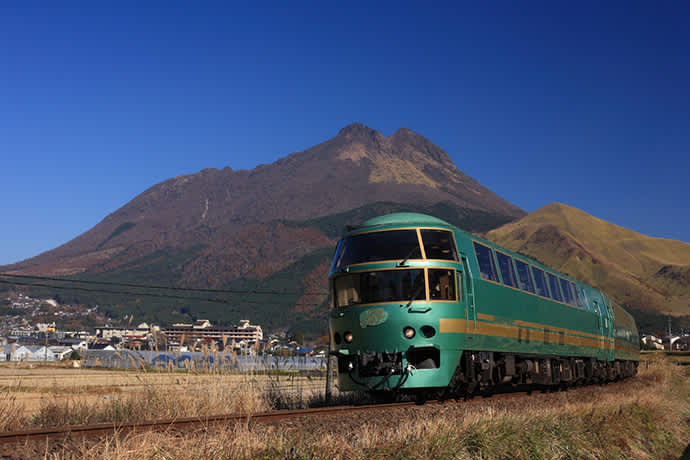
Industrial designer Eiji Mitooka was involved in the stylish, modern design. Photo credit: JR Kyushu
Main photo credit: Hisatsu Orange Railway inc.
Information
Ibusuki no Tamatebako |
Orange RestaurantReservations should be made online, at least three days in advance. |
|
WEB:https://www.hs-orange.com/kankou/reserve/pub/default.aspx?c_id=22 |
Aru Ressha |
JR Kyushu reservations |
JAPAN RAIL PASS |




















































